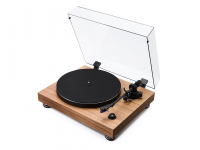
Monitor Audio bring High Fidelity to the masses…
As nice as it is to spend time with bleeding-edge, top of the range hi-fi gear, nothing beats a bargain. Unearthing a gem that punches way above its (relatively) diminutive price tag, can put a smile on the face of any shopper (your average audio enthusiast included). When Monitor Audio, of multi-award winning BX series speakers fame, announced a new range of speakers at an even fairer price than the BXs, we were intrigued. Come and meet the Monitor Audio MR (Monitor Reference) range!
The series consists of: a small set of bookshelf speakers – MR1, a large set of bookshelf speakers – MR2, two sets of floorstanders – MR4 & MR6, a centre speaker – MR Centre, and a subwoofer- MRW10.

Monitor Audio – MR6
Immediately striking on first inspection is the shiny gold tweeter, from behind its child-proof (so sensible!) mesh cover. This tweeter, which Monitor Audio refer to as the C-CAM, is shared across the range. It can also be found on the aforementioned BX series. Listeners to these will note their fantastically clear treble, but also their lack of stridency. It’s a fairly common (mis)conception that metal tweeters strip paint off walls. It is fair to say that if done badly this is sometimes the case. When applied correctly however, these tweeters are able to give startlingly clear highs, and bring a level of clarity that a ‘soft-dome’ tweeter can sometimes struggle to achieve. The balance between clarity and harshness is a fine one and the ceramic-coated aluminium used in the C-CAM is the aural equivalent of an experienced trapeze artist, carefully walking that tightrope of musicality and hi-fi. Monitor Audio’s use of anodised gold to increase thickness, and in turn help with damping also goes a long way in keeping this balance.
The drive units used are on Monitor’s own MMP II, and are used in a lot of their Custom Install speakers. They are robust, using a polypropylene base that’s then injected with metallic particles for added stiffness. They’re also a tidy pearlescent white finish, which adds a bit of glamour.
Fit and finish are good for the money, but they lack a little bit of pizzazz in comparison to their pricier brethren. This is obviously to be expected, but the quality certainly isn’t poor. It’s reassuring to know that the money here has gone into the important bits, and a slight drop in ‘wow’ factor is more than acceptable. Single wire terminals are provided around the back, and these allow for use with banana plugs, as well as straight forward cable.
All of the speakers present an amplifier with an easy load, and can be driven with relatively minimal output power. We used the speakers to great effect with the Cambridge Audio 351A, as well as the Marantz PM5005. Switching up a gear to the Cambridge 651A and the Marantz PM6005 brought its own gains, and if you’re looking to build a system around some of these speakers, it’s nice to know that they scale up well.
The Bookshelves
First up for a listen were the dainty MR1s and their slightly bulkier big brother the MR2s. It’s not exactly music for the faint hearted, but the recent return of electronic genius Aphex Twin, and his track minipops 67 [120.2][source field mix] gives us a great chance to check out how well the speakers can cope with huge dynamic shifts. The track is a melting pot of acid-y analogue squelches, skittering drum patterns and mangled vocals. With so much going on, a speaker needs to be able to respond to fluctuations on a knife edge if the track isn’t to fall into mushy mayhem. The MRs gave a fine account of themselves, with the MR2 in particular showing its fine bass control from its forward-firing port. The MR1 too was assured in its approach to such dense noodling, with a bit of close wall proximity giving a boost to its lower register output. All in all, the ‘signature’ sound of the Monitor Audio brand was obviously present: clear, detailed highs, and well-groomed bass – tidy and punchy.
The Floorstanders
Having two sets of floorstanders in the range allows for more flexibility when picking a speaker that’ll fit your room size and shape. If you love a bit of bass but you’ve got a relatively compact room then the M4 are going to be right up your street. If you’ve free reign to go all out, or you’ve just got a particularly large room then the M6 is going to be better suited. Out and out rock music was in order to really let us here what these were capable of, and System of a Down‘s 2001 classic Toxicity is as good a test disc as you’ll find in the genre. Produced by the band themselves and Rick Rubin, the sonic dexterity on show makes other metal albums seem dour in comparison. Science is all buzzsaw guitars and pummelling drums. Through the MR4 the guttural guitars blast with enormous force, creating the long cliched ‘wall of sound’ to great effect. The soundstage isn’t enormous, certainly not as panoramic as more expensive models, but when you’re having this much fun, does it really matter? Positioning was good, separation was excellent and foot-tapping was present throughout!
As you’ve probably guessed by now, we really liked these speakers. They were assured, powerful when needed, and offered beautiful, extended highs. They’re a great upgrade to a long-in-the-tooth pair from an older system, or a cracking first set of speakers for those just starting out.
Shop for Monitor Audio on the Richer Sounds website today!
Give your local Richer Sounds store a call to arrange a demo today – you bring the tunes, we’ll supply the coffee!





